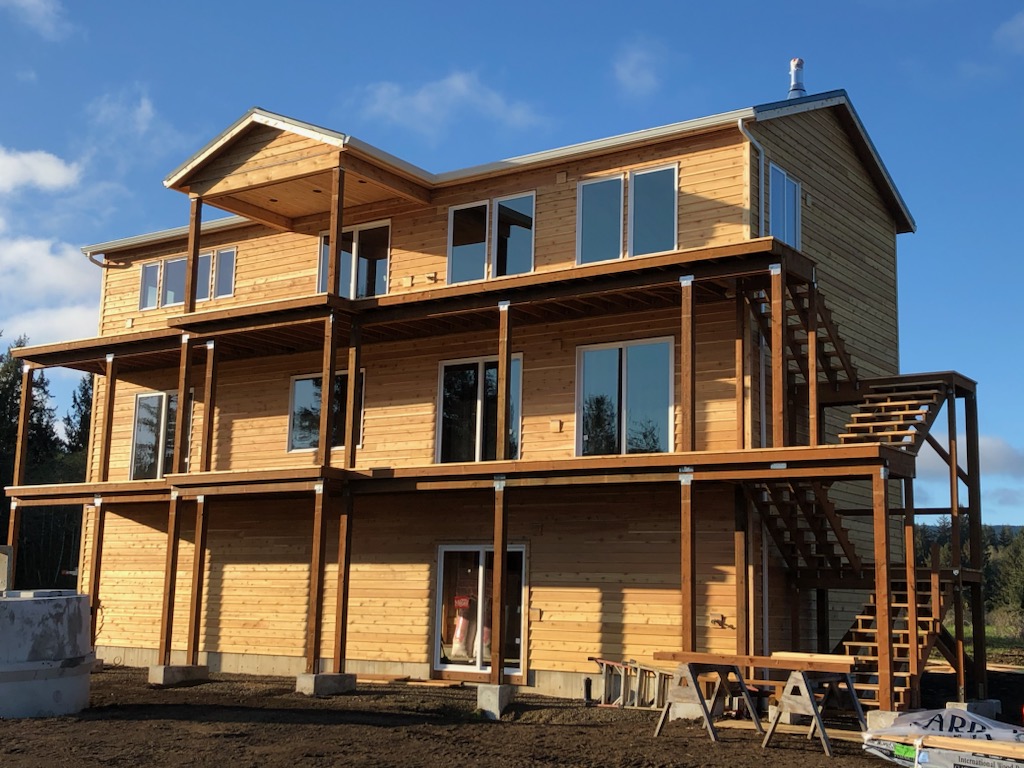Cedar Siding: Advantages, Disadvantages, and Maintenance

What is Cedar Siding?
Cedar siding is one of several types of wood siding used on homes. It offers a natural look to your home, while also protecting it from the elements. Cedar siding is made of Western red cedar, a softwood that grows in the Pacific Northwest and Alaska. The wood is kiln-dried and milled into boards, which are then sawn and finished to create siding.
Cedar is naturally resistant to rot, insects, and decay while also being very durable. It can last for decades without needing to be replaced. Cedar siding is available in a wide variety of colors and textures, which makes it easy to find the right match for any home.
Cedar siding is widely regarded as one of Earth's most valuable and beautiful natural resources because of its exceptional strength-to-weight ratio, dimensional stability, and low density.
The wood's natural golden hue and straight grain go well with many different architectural designs and appeal to a wide range of homeowners.
What Are the Advantages of Cedar Siding?
Cedar Siding is Durable
Cedar siding is one of the durable woods that are naturally resistant decay, insect attacks, and moisture absorption. This makes it an ideal material to use for siding, as it can last for decades without needing to be replaced.
You can find cedar siding in a wide range of dimensions, textures, and grades, which makes it easy to find the right match for any home. Cedar siding is also available in a variety of colors, from light to dark, which makes it easy to find the right shade for your home.
Cedar is very low maintenance compared to other types of siding. It doesn't require painting or staining and only needs to be cleaned occasionally to keep it looking its best. It's also one of the more environmentally friendly options because it's a renewable resource grown in managed forests. The wood is harvested, milled, and kiln-dried using sustainable practices.
Cedar siding can easily stand up to a wide variety of outside forces including weather, impact, and pests, making it an ideal material to use for siding.
Cedar Siding is Energy Efficient
Cedar siding is an energy efficient choice for your home. It can serve as a natural insulator, so you will need less energy to heat and cool your home. Cedar also has low rates of greenhouse gas production.
Because lumber is minimally processed, it stores more carbon than the manufacturing of other siding materials, making it a more eco-friendly option. In fact, lumber makes up over 40% of building materials but only 4% of construction market's production energy.
Cedar siding is energy efficient because it reduces the total energy expended to produce your siding. Cedar shingles are a green choice you can feel good about because they reduce the total energy expended to produce your home's exterior.
Cedar Siding Increases the Value of Your Home
Cedar siding is a natural material that has broad appeal. It's an investment that will increase the value of your home.
Cedar is one of the most popular siding choices for homeowners and homebuyers alike. It's a classic material that has been used for centuries, and its popularity is only increasing. It also has the advantage of being environmentally friendly and doesn't release harmful VOCs into the air. This can be an attractive selling point for green-minded homebuyers.
What Are the Disadvantages of Cedar Siding?
Cedar Siding Can be Expensive
Compared to other siding options, cedar can be expensive. The initial cost of cedar siding may be higher than other materials, but it's important to keep in mind that cedar is a long-lasting material that won't need to be replaced as often. In the long run, cedar siding can be a cost-effective choice.
Cedar Siding is Susceptible to Rot
Because it can be more susceptible to rot than other siding materials, cedar needs to be protected with either a layer of paint or stain. That said, cedar's natural oils help it act as an organic preservative, protecting the wood from certain types of rot and pests - especially insects.
Cedar Siding is Susceptible to UV Damage
Cedar siding is susceptible to UV damage, potential damage by pests and animals such as woodpeckers, as well as natural weathering if left unpainted or unstained. The biggest concern with cedar is its potential to crack or leak as a result of the concerns listed above.
Cedar Siding Requires Regular Maintenance
The best way to ensure cedar siding lasts long is to make sure it receives regular maintenance to prevent rot, cracking, and warping. Cedar siding has natural antibacterial and anti-fungal properties which allows you to leave the wood untreated. However, it can be better protected against the elements with a layer of paint or stain.
Of course, untreated cedar weathers differently which can offer a more rugged look than stained cedar siding offers.
Cedar siding requires washing and staining/sealing or painting on a regular basis. And homes in dusty climates will require even more frequent washing.
Walls that are exposed to sun and high heat will fade faster than those that are not, so they'll require more frequent staining or painting to protect the wood from damage. Iron stains caused by iron fasteners: Cedar should be installed with hot-dipped galvanized, aluminum or stainless steel nails to avoid staining. However, if iron nails were used and rust stains occur, the staining can be removed with a commercial cleaner prior to staining or painting the siding.
Cedar siding requires regular cleaning and maintenance to look its best.
The paint on cedar can fail due to moisture exposure, which requires that it be washed and repainted. Peeling, flaking or blistering indicate that the wood behind the paint is wet and needs to be remedied.
How Often Does Cedar Siding Need to Be Replaced?
It's smart to properly maintain cedar to help ensure it reaches its maximum lifespan. Depending on the climate, and quality of care and regular maintenance, cedar can last decades. If left untreated, however, it may only last 10-15 years.
What is the Best Way to Clean Cedar Siding?
Ideally, cedar should be cleaned twice per year. Cleaning it with soap and water followed by washing it down is the best way to clean cedar siding. Mold and mildew problems may require you to use bleach to deal with it, but the best solution is to talk to pros about your specific situation. When you're done, make sure to wash off the area where the soap and water solution has been added.
Some other options for cleaning include the use an alkyd-oil-based primer and a mold and mildew inhibitor, a cleaner that contains lysol or alcohol, or even a pressure washer. However, before you consider using any of these methods, we recommend you consult with an exteriors professional to ensure you're using the best possible method for your home.
Should You Invest in Cedar Siding for Your Home?
Cedar siding is the number one most popular type of wood siding and can last up to 25 years or longer with proper maintenance. It can be a great choice for homes that need to be resistant to weather conditions and pests.
That said, cedar siding can be a costly up-front investment and may not be suitable for all homes.
When considering cedar siding for your home, it's also important to choose a contractor that you trust, as there are risks involved with hiring an inexperienced siding installer. Because of the maintenance required, it's also important to factor in the cost of regular cleaning and staining or painting when making your decision.
If you're looking for an attractive, long-lasting siding option, cedar siding may be the right choice for your home we'd be happy to help you explore your options. Contact us today to learn more about cedar siding and get a free quote for your home.

